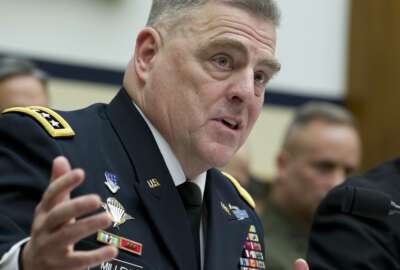
Mattis says CR hurts personnel, contracting and readiness
Defense Secretary James Mattis sent a letter to Congress outlining exactly what a three month continuing resolution does to the military.
The Defense Department says Congress’ continuing resolution that lasts until Dec. 8 will have substantial negative impacts on training, readiness, contracting and personnel.
In a Sept. 8 letter signed by Defense Secretary James Mattis and sent to the Senate Armed Services Committee, DoD outlined just exactly what the 90-day CR will do to the department.
“Long term CRs impact the readiness of our force and their equipment at a time when security threats are extraordinarily high. The longer the CR, the greater the consequences for our force,” the letter stated.
The CR, which Congress passed last week, funds DoD at $593 billion — the same funds it received last year. DoD requested $639 billion for 2018 and congressional leaders have been considering giving DoD upwards of $700 billion.
Mattis’ letter reminds lawmakers that DoD is unable to start any new programs, reprogram 2018 funds or enter into any new contracts while under a CR.
Those restrictions have far reaching effects.
“A continuing resolution prevents the military from reprogramming funding to meet emerging needs. It prohibits the start of new programs to modernize for future threats. And it locks the Department of Defense into previous funding levels, mandating a level of spending that is $89 billion less than the fiscal year 2018 funding level passed unanimously in the Senate Armed Services Committee bipartisan markup of the National Defense Authorization Act,” Senate Armed Services Chairman John McCain (R-Ariz.) said in a Sept. 12 statement.
Personnel
Mattis’ letter stated the three month CR freezes most hiring actions and recruitments. Vacancies are unable to be filled and DoD must start the hiring process all over again for open positions.
“This disruption leaves critical gaps in the workforce skill set and causes unnecessary angst among military and civil servants, making the government a far-less attractive option to the highest skilled potential candidates,” the letter stated.
DoD is in a battle with private industry for talented cyber-trained people and innovative thinkers. Mattis makes the case that uncertainty is not helping DoD’s side.
Additionally, both Congress and the President want to add military personnel to meet critical skill gaps in areas like cyber, pilots, maintainers and nuclear-trained personnel. The CR will delay that process.
It’s not only recruitment in personnel that will be affected. Those in the military and civilian DoD workers will have professional development and training delayed.
Non-critical travel, which includes permanent changes of station, will be curtailed.
“This often results in missed hiring opportunities as potential employees pursue other options. It creates unnecessary turmoil for families who had otherwise planned to relocate … and may then result in missed school year timing for dependent spouses and children,” the letter stated.
The CR will also cause payments to medical care providers on behalf of patients to be delayed. Mattis stated that could cause providers to discontinue services to patients with TRICARE in the future.
Contracting
Acquisition officers are in a tough bind when CRs are enacted and Mattis makes no light matter of it.
“The impacts of a CR on DoD contracting efforts are significant and begin within the first 30 days of each CR. Every contract that has to be re-competed represents additional work for the already pressed DoD acquisition workforce,” Mattis stated. “In addition to these increased administrative costs, new start rules and funding constraints carried forward under each CR extension combine to increase the likelihood that costs of material and labor in the contracts themselves will also grow,” the letter stated.
Because DoD is unable to begin any new programs or increase the production of a product, the military services must delay multiple systems.
During the time of the three month CR the Army had 18 new programs and eight production rate increases planned. Those included the Paladin Integration Management Improvement, the Interim Combat Service Rifle, the Multi-role Anti-armor Anti-personnel Weapon System and the Lightweight 30mm Cannon.
Navy and Air Force programs are not affected by the three month CR, but if it were to expand to a six month CR the Navy would have seven programs in the line of fire and the Air Force would have six.
Readiness and Maintenance
Mattis stated the impacts of a CR on readiness will be felt immediately and “grow exponentially over time.”
DoD made a push in the 2017 and 2018 budget to recapitalize on some of the readiness it feels it lost in years past.
Readiness and maintenance issues have been on full display as two Navy ships were involved in collisions this summer and multiple aircraft crashed this year.
The three month CR will cause the Navy to delay the induction of 11 ships. That, Mattis says, will exacerbate the planned ship maintenance in 2018 and with slip ship availabilities in 2019.
The Navy will also have to reduce flying hours to units that are not deployed and delay the replenishment of spare and repair parts for ships, submarines and aircraft carriers.
The Army will be forced to postpone all non-critical maintenance work orders, another large issue within the military after a 2016 study found one in five DoD facilities are now in failing condition.
The Army will have about $400 million less per month in operating accounts. The service will have to start restricting home station training as a result.
Training
Mattis’ letter states the impacts on training will begin within the first month and the military will lose unrecoverable training time due to subsequent training events by the end of the 90 day CR.
“These training losses reduce the effectiveness of subsequent training events in 2018 and in subsequent years,” Mattis stated.
Mattis explains that most training events are scheduled for the spring and summer. But prerequisite training must be completed before that training starts. The CR forces the military to rescope the amount of training it can do beforehand causing units to enter major exercises less prepared.
Under the CR the Air Force will not have the funds to stand up two F-16 training squadrons. The CR will reduce aircraft availability and keep the service from growing its force.
The Air Force is supposed to grow to 321,000 active duty airmen. The lack of training and recruitment will reduce pilot production leaving service “unable to train the number of pilots necessary for continued readiness recovery,” the letter stated.
The Air Force is currently facing a pilot shortage of almost 1,600.
The effects of multiple CRs
CRs have become part of the yearly cycle in Congress. Congress hasn’t passed a budget on time for seven of the last eight years.
Army Chief of Staff Gen. Mark Milley said the culmination of CRs is taking its toll.
“It’s the cumulative effect. We’ve been doing CRs now for eight years and a shutdown in [20]13,” Milley told Congress this spring. “It’s like smoking cigarettes. One cigarette is not going to kill you, but you do that for eight, 10, 20 years, 30 years, you’re eventually going to die of lung cancer.”
Still, the Defense Department isn’t exactly stingy with its money either.
Critics are worried the defense budget is becoming unbearably bloated with waste and lawmakers are just throwing more money at the problem.
DoD is the only government agency that is not audit ready. It is not fully accountable for the money it spends.
A high profile 2015 report from the Pentagon stated DoD could save $125 billion over five years just by cutting contractors and streamlining some practices. That money could be saved without firing a single person.
Copyright © 2025 Federal News Network. All rights reserved. This website is not intended for users located within the European Economic Area.
Scott Maucione is a defense reporter for Federal News Network and reports on human capital, workforce and the Defense Department at-large.
Follow @smaucioneWFED





